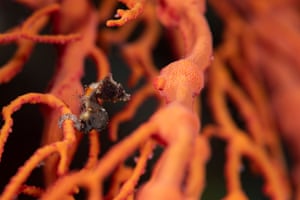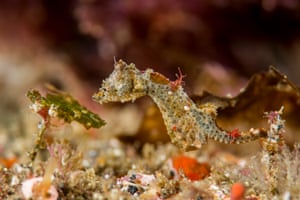After spending hundreds of hours observing pygmy seahorses for my doctorate, I knew exactly when Tom, a Denise’s pygmy seahorse in Sulawesi, Indonesia, would give birth. He swam with great resolve (1) from where he slept each night with his partner, Josephine, against the current, to the edge of the gorgonian seafan (a type of coral) that the two inhabited.
He never faltered. At the edge of the coral, the current was at its strongest, offering the greatest chance of sweeping his offspring out to the relative safety of the open ocean.

-
1. ‘Tom’ swims off to give birth
Having grabbed on to the edge of the gorgonian with his tail, Tom began to give birth. Over several occasions I witnessed him release between six and 12 fry. The labour was obviously arduous and he was crunched over, panting for breath. Two of the dark-coloured fry are seen here (2) forcefully being expelled from his brood pouch. With adults measuring less than 2cm in length, the fry are just 2-3mm long. Their dark colour gives them some degree of camouflage in the open ocean and they will spend two to three weeks floating freely in currents, before settling to a gorgonian of their own.

-
2. Tom gives birth to two fry
It took Tom a little while of crunching, drawing in water and crunching again before the last baby finally popped out (3). The juvenile had been with its siblings for almost two weeks in the brood pouch. When they are born, aside from colour, they appear to be miniature versions of their parents. It’s not until they settle to a new gorgonian that they adapt in surface texture and colour to match their particular home. I recorded the transition of a juvenile pygmy seahorse and it took five days to become a perfect match with the gorgonian.


-
3. Tom holds open his brood pouch with one last baby still remaining. 4. Tom seen with his wrinkled, now empty, brood pouch
After all the babies have finally been released, the male pygmy seahorse is perhaps the only male in the animal kingdom to truly suffer from stretch marks. His empty brood pouch was now wrinkled (4) following the birth of the fry he had been carrying. Although he was clearly quite exhausted, Tom immediately headed back to where Josephine was resting. There wasn’t a moment’s respite for him, as Josephine quickly emerged and began a series of ritualised quivers to convey her intention to proceed to the next part of the reproductive cycle.


-
5. Just 20 minutes after giving birth, Tom’s tail is entwined with Josephine’s. 6. Josephine pushes more unfertilised eggs across to Tom’s empty brood pouch
After a series of ritualised dances, Tom and Josephine both released their grip of the gorgonian coral and their tails intertwined (5). Tom was still very deflated after having given birth 20 minutes or so before. Josephine, on the left, is clearly rather plump because she is full of a clutch of unfertilised eggs. Females begin to hydrate their clutch a few days before mating. The daily courtship rituals are carried out to help synchronise the pair’s reproductive cycles. It is important the female doesn’t begin to prepare the eggs for mating too early as they may spoil if the male is not ready.
It took 45 seconds for Josephine to push the unfertilised eggs across to Tom’s empty brood pouch (6). As they entered his reproductive system he fertilised them. The sequence allowed Tom to be certain that each and every baby he would carry would be his own. This certainty of paternity is extremely rare in the animal kingdom, and explains why male seahorses put so much effort into raising their offspring. It was an honour to be the first person to witness and record this series of events.

-
7. A gorgonian seafan
Bargibant’s and Denise’s pygmy seahorses live exclusively on the surface of gorgonian seafans (7). These seahorses are very hard to find because of their miniature size and fantastic camouflage, so knowing which species of gorgonians they live on is a huge help. Gorgonians are fan-like corals that can get as large as a car’s windscreen. They attach to the reef where ocean currents hit, bringing large volumes of nutrients. They are covered in polyps that trap plankton for food. These are animals, not plants, so don’t need sunlight for energy.

-
8. The Japanese pygmy seahorse, Hippocampus japapigu
In 2013 I was in Okinawa in Japan to attend a conference. Years before, I had seen a picture of an unusual pygmy seahorse taken in Japan that piqued my interest. After hours trawling the internet, I tracked down a location where I thought I might find it and headed to the small island of Hachijo-jima, south of Tokyo. Amazingly, over the course of a few days I managed to find more than a dozen of them (8) and was sure they were distinct from all others I had seen before.
It wasn’t until I was presenting at another conference a few years later that things started moving forwards. During my keynote presentation, I mentioned these pygmy seahorses and that I was sure they were a new species. Graham Short, an expert in seahorse taxonomy, came and spoke to me, which immediately began a flurry of seahorse excitement. Eighteen months later, we named the new 2cm-long pygmy seahorse Hippocampus japapigu (9). At the time, it was thought to only occur in the waters off Japan, but it has since been confirmed as far south as Taiwan.


-
9. The Japanese pygmy seahorse has also been found off the coast of Taiwan. 10. The South African pygmy seahorse, Hippocampus nalu, was recognised as a new species in May
In May of this year, colleagues from the International Union for Conservation of Nature and I named a new species of pygmy seahorse, Hippocampus nalu (10). A few months earlier, a dive guide had spotted it in Sodwana Bay, in north-eastern South Africa. I went with a colleague to observe it first hand. It is the first pygmy seahorse to have been recorded anywhere in the Indian Ocean. The waters off South Africa are quite wild, and it wasn’t easy to find and photograph them as each surge wave dragged me several metres away from the subject.

-
11. A pygmy pipehorse, a close relative of the seahorse, found off the coast of New Zealand
Several years ago a diver came across a strange fish and assumed it was New Zealand’s first indigenous seahorse. It was, in fact, a new species of pygmy pipehorse (11), a very close relative of the seahorse. I managed to capture one of the only images of this species in the wild in 2017. At that time, it hadn’t been seen in over six months. The pipehorse is only 5-6cm long with immaculate camouflage. I found a pair clinging to a tiny algal frond.

-
12. A ‘velvet’ ghost pipefish
An undescribed species of ghost pipefish, commonly known as the velvetghost pipefish (12), tends to live around brightly coloured sponges, and each individual pipefish matches exactly the colour of the sponge immediately adjacent to where it lives. There are half a dozen or so other ghost pipefishes found across the Indo-Pacific oceans, and each is highly adapted for its habitat. Some are white, others pink or even scarlet. They usually live in male-female pairs that hunt tiny shrimps and other crustaceans.

-
13. A thread pipehorse, Kyonemichthys rumengani
Since the turn of the millennium there has been a flurry of discoveries of miniature fishes. I believe this is because the megafauna – such as sharks, turtles and rays – around south-east Asia have dwindled to such an extent that recreational divers and their guides began to look at smaller creatures to satisfy their curiosity. This thread pipehorse, Kyonemichthys rumengani (13), was described in 2007. It is just 2.6cm long and looks like several intertwined hairs moving around. Just like seahorses, these fish brood their young in a pouch on the male’s belly.

-
14. A Lynne’s pipefish, Festucalex rufus, which is the size of a cocktail stick
Lynne’s pipefish, Festucalex rufus (14), was only named in 2015. Again, it evaded detection owing to its small size, habitat specificity and highly efficient camouflage. It is the size of a cocktail stick and lives only among little patches of a certain sponge found on coral reef walls below around 15 metres depth. It matches the sponge exactly in texture and colour, and even when you’re looking directly at one, it’s almost impossible to see it.

-
15. A Walea soft coral pygmy seahorse, Hippocampus waleananus, found in Indonesia
Two risk factors for a species’ chance of extinction are their habitat specificity and geographic range. This pygmy seahorse (15) was named in 2009 as the Walea soft coral pygmy seahorse, Hippocampus waleananus. In the year before it was described, I observed it in the wild and am one of the few to have done so. It is only found in one small bay in central Sulawesi, Indonesia, where it lives only on the surface of certain soft corals. There has never been any research on their biology but the relative risks to their populations are great.

-
16. A Pontoh’s pygmy seahorse, Hippocampus pontohi
Just one species of pygmy seahorse was known before the turn of the millennium. Since then, another seven have been added to the list. I took this image of Pontoh’s pygmy seahorse, Hippocampus pontohi (16), which was named in 2008, in February this year in Indonesia. The dark-coloured Pontoh’s were originally described as a distinct species, but genetic analysis has shown that they are the same as the white form. Seahorses are extremely variable in colour and surface texture, which has led to many new species being erroneously named over the years.

-
17. Genetic analysis shows the Japanese pygmy seahorse split from all others around 8 million years ago
The Japanese pygmy seahorse (17) appears superficially similar to several others, but genetic analysis shows it split from all others around 8 million years ago. It has a few morphological differences, too, which allow the trained eye to identify it. Unlike Bargibant’s and Denise’s pygmies, which live on the surface of gorgonian corals, I found the Japanese species grasping to the algal tufts that cover the huge volcanic boulders found around Hachijo-jima. Because of this, it is much harder to find them. The large swells off Hachijo mean it’s difficult to stay still enough in the water to keep an eye on them.

-
18. A rare, pristine coral reef, in West Papua, Indonesia
Sadly, pristine coral reefs like this one in West Papua, Indonesia (18), are becoming much harder to find. One of the greatest threats comes from coral bleaching. When the water around coral reefs is 2C above the average for the time of year, the symbiotic algae within the coral’s cells become stressed and leave. The algae contain photosynthetic pigments that provide energy to the coral. In exchange, the coral provides the algae with its own waste products, which act as a fertiliser. Without the algae, coral is left ghostly white. Some researchers believe coral reefs in their current form may not survive beyond 2050. That, in turn, means the pygmy seahorse faces an uncertain future.
The World Beneath: The Life and Times of Unknown Sea Creatures and Coral Reefs by Richard Smith is published by Apollo
Find more age of extinction coverage here, and follow biodiversity reporters Phoebe Weston and Patrick Greenfield on Twitter for all the latest news and features